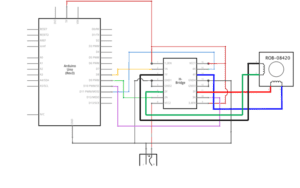Recitation 4: Drawing Machines (by: Lifan (Sylvie) Yu, ly1164)
In this recitation me and Kurt made a drawing machine using potentiometer to control a motor which is attached to laser-cut arms that control the a pen to move. We used this machine to draw on a piece of paper.
Materials:
For Steps 1and 2
1 * 42STH33-0404AC stepper motor
1 * L293D ic chip
1 * power jack
1 * 12 VDC power supply
1 * Arduino kit and its contents
For Step 3
2 * Laser-cut short arms
2 * Laser-cut long arms
1* Laser-cut motor holder
2 * 3D printed motor coupling
5 * Paper Fasteners
1 * Pen that fits the laser-cut mechanisms
Paper
Circuit:

Step 1: This circuit is the most complex one I’ve encountered so far. I made mistakes in connecting the jumper wire to the correct spots. I also put the H-bridge in the wrong direction. However with the help of IMA fellows I finished building the circuit. We used the function “map()” in order to match the movement of the knob with the rotation of the motor.
Step 2: There was a moment when I thought this circuit couldn’t work properly. When I rotated the knob on the potentiometer, the knob on the motor did not rotate immediately. But it was just the delay. It still worked well.
Step 3: I found it a bit difficult to control the movement of the pen using a knob that’s both far away from it and which controlled it indirectly. Then we figured out how the rotating movement can be turned into a linear or curvy movement. We really enjoyed making abstract art with this.
Question 1:
What kind of machines would you be interested in building? Add a reflection about the use of actuators, the digital manipulation of art, and the creative process to your blog post.
The machine I would like to create is a machine that uses moisture sensors to sense whether plants need watering and reminds people of when to water the plant and how much water should be added into the soil. When the soil is dry and the plants need watering, the machine will carry the plant and move up and down to remind people of watering the plants. When too much water was poured into the soil, a servo will rotate a hand-shaped sign to remind people of stop watering the plants.
Question 2:
Choose an art installation mentioned in the reading ART + Science NOW, Stephen Wilson (Kinetics chapter). Post your thoughts about it and make a comparison with the work you did during this recitation. How do you think that the artist selected those specific actuators for his project?
The interactive artwork Waves. Motors in it rotate elastic strings to create complex sounds and visual oscillations. It responds to the different movements of viewers and in a sense present the movements in a transformed, artistic but also corresponding way.
The project we made is actually controlled by people. Unlike the project I read about that senses movements of people. But they both converse certain movements of the viewer into new forms of movements that create artistic results.